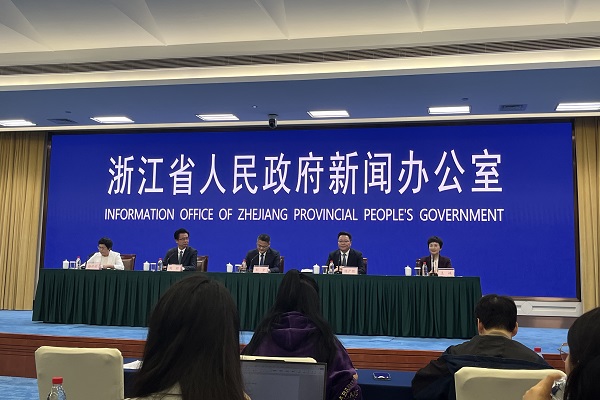why china's pro-consumption policies are not meant to be effervescent tablets
skeptics and naysayers of china's consumer spending strength faced a stark reality check as the country's annual online shopping extravaganza reached its climax monday, demonstrating the robust consumption power of the world's second-largest economy.
e-commerce giants, including alibaba and jd.com, reported impressive increases in revenues and user numbers during this year's extended singles' day shopping festival, running from october to mid-november.
the annual deal-making frenzy, concurrent with the chinese government's implementation of a series of heavyweight growth-boosting measures, including massive consumer goods trade-ins, could demonstrate the effectiveness of the chinese government's policies.
a showstopper of the consumer event is a surge in the sales of goods eligible for the government trade-in program. jd.com saw over 200 percent year-on-year growth in transaction volume across more than 500 home appliance and furniture categories, while retailer suning's trade-in sales skyrocketed by 247 percent.
despite the stronger market vibrancy, some overseas narratives have recently and persistently misrepresented or distorted the consumption panorama, often out of outdated frameworks. the so-called "consumption crisis" is more myth than reality; claims of an "underwhelming stimulus" are mere premature assertions; and the notion of china "not ready to shift to a consumption-driven economy" misses the mark by a thousand miles.
most of the misinterpretations about china's economic policies stem from expecting them to work like effervescent tablets dropped into water. some cling to the old habit of anticipating a rapid, dramatic reaction in the form of a sudden burst of bubbles and activities that appear to dissolve economic challenges quickly. this expectation leads to impatience and misunderstanding.
china's approach is more nuanced and balanced and often focuses on long-term solutions. unlike the quick but fleeting effect of an effervescent tablet, beijing's economic strategies eye a sustained impact that not only shores steady growth but also eventually leads to higher-quality development.
the government has implemented systematic measures to unlock the nation's vast consumption potential. these include increasing fiscal input, boosting people's incomes, removing market barriers, and opening new consumption frontiers through technological innovation and further opening up.
some of these policies have already shown effectiveness. a powerful example is the consumer goods trade-in program, with 150 billion yuan (20.7 billion u.s. dollars) raised via ultra-long special treasury bonds allocated to local governments for its implementation. the impact is already visible, not just in the surging spending on home appliances. car sales reversed their decline in october, with new energy vehicle sales climbing 49.6 percent year on year.
the broader economic indicators have painted a more encouraging picture. e-commerce logistics reached a five-year peak in business volume in october, while spending on consumer services showed renewed vigor at a faster pace, particularly in hospitality and dining.
other policies take time to make an impact. a recent move to increase the local government debt ceiling by 6 trillion yuan, while primarily addressing hidden debts, will allow local governments more fiscal room to increase investments in public welfare. this is key to the long-term expansion of consumption, as it addresses fundamental factors that inhibit consumer behavior and spending power.
it would be misguided to understate the chinese government's commitment to rebalancing the economy. consumption is already the country's main engine for economic growth. in the first three quarters of 2024, consumption contributed 49.9 percent of the country's economic growth, substantially surpassing investment, which accounted for 26.3 percent.
moreover, rather than positioning consumption and investment as competing priorities, china aims to foster a virtuous cycle between the two. the carefully calibrated suite of supportive policies underscores the nation's holistic approach to boosting consumption and its resolve to harness all its resources efficiently, not only to meet annual economic targets but also to cultivate sustainable, high-quality growth through structural reforms.
from this perspective, claims that china's so-called "collectivist approach to economic planning" stifles consumer spending oversimplify a rich reality. such claims represent a convenient yet flawed narrative, often propagated by those who fail to grasp china's adept economic management -- a strategy that deftly combines the roles of the market and the government.
this effective mode helps form a diverse and growing middle class in china eager for quality products and services, with stronger consumer confidence than in many other parts of the world. mckinsey's consumerwise survey in august revealed that 59 percent of chinese consumers expected an economic rebound within months, far surpassing optimism in the united states, the united kingdom, and japan, even before incremental pro-growth measures kicked in.
foreign companies recognizing chinese consumers' immense purchasing power and evolving tastes are expanding in china. canadian athletic apparel brand lululemon, having experienced strong growth since entering the chinese mainland in 2013, expects the market to become its second-largest worldwide, with over 200 stores by 2026.
china's consumer landscape isn't a simple story of boom or bust but a complex tale of exciting transformation. avoiding the "effervescent tablet mentality" is key to accurately assessing china's consumer landscape. by capturing the nuanced changes and new opportunities with patience and perspective, businesses and observers can uncover a market and a wealth of enduring potential in one of the world's most dynamic consumer bases.
-
second liangzhu forum set for nov 25–27 in hangzhou
november 13, 2024
-
hangzhou delegation aims big for 7th ciie
november 5, 2024
-
hangzhou marathon concludes with new records
november 4, 2024
-
on board g8388: lost in the qiandao lake — a unique aerial island maze
september 29, 2024

